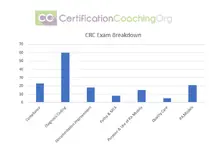

The CRC Exam
- 150 multiple choice questions
- 5 hours 40 minutes to finish the exam
- One free retake
- $399 ($325 AAPC Students) - one free retake
- Open code book (manuals)
The CRC exam thoroughly covers:
Compliance
- 23 multiple choice questions
- Identify common coding errors identified in RADV audits
- Understand the process for prospective audits
- Understand the process for RADV audits
- Understand the process for retrospective audits
- 60 multiple choice questions
- Demonstrate the ability to apply the Coding Clinic guidance to coding scenarios
- Demonstrate the ability to properly code amputations
- Demonstrate the ability to properly code artificial openings
- Demonstrate the ability to properly code atherosclerosis
- Demonstrate the ability to properly code AV fistulas
- Demonstrate the ability to properly code CHF
- Demonstrate the ability to properly code CKD
- Demonstrate the ability to properly code complications of devices
- Demonstrate the ability to properly code COPD
- Demonstrate the ability to properly code CVA/Stroke
- Demonstrate the ability to properly code dementia
- Demonstrate the ability to properly code depression
- Demonstrate the ability to properly code DVT
- Demonstrate the ability to properly code hypertension
- Demonstrate the ability to properly code malnutrition
- Demonstrate the ability to properly code manifestations of diseases (eg, DM, stroke, COPD)
- Demonstrate the ability to properly code mental disorders
- Demonstrate the ability to properly code neoplasms
- Demonstrate the ability to properly code pneumonia
- Demonstrate the ability to properly code pressure ulcers
- Demonstrate the ability to properly code pulmonary embolism
- Demonstrate the ability to properly code pulmonary fibrosis
- Demonstrate the ability to properly code seizures
- Demonstrate the ability to properly code skin ulcers
- Identify common coding errors in risk adjustment
- Identify diagnosis codes that risk adjust
- OBGYN specific conditions that risk adjust
- Pediatric specific conditions that risk adjust
Documentation Improvement
- 18 multiple choice questions
- Communicate documentation discrepancies with providers
- Identify documentation discrepancies
Pathophysiology/Medical Terminology/Anatomy
- 8 multiple choice questions
- Identify common acronyms for industry terminology
- Identify common acronyms for medical terminology
- Identify the anatomic structures, locations and functions
- Understand disease processes and interactions for common chronic conditions
- Understand the meaning of common medical terminology
Purpose & Use of Risk Adjustment Models
- 15 multiple choice questions
- Demonstrate the ability to apply trumping in the risk adjustment hierarchy
- Understand the use of data mining from data captured through risk adjustment coding
- Understand the use of predictive modeling from data captured through risk adjustment coding
Quality Care
- 5 multiple choice questions
- Understand the purpose of HEDIS and alignment with risk adjustment
- Understand the purpose of STAR ratings and alignment with risk adjustment
Risk Adjustment Models
- 21 multiple choice questions
- Demonstrate the ability to apply the ACA risk adjustment model
- Demonstrate the ability to apply the CDPS risk adjustment model
- Demonstrate the ability to apply the HCC risk adjustment model
- Demonstrate the ability to apply the private payers risk adjustment model
- Understand elements needed to determine the risk adjustment score
Certified Risk Adjustment Coder (CRC) - Certification Exam
Prepare for CRC exam & certification to become certified risk adjustment coder and earn 40% more than non-credentialed coders. AAPC helps you with CRC prep.
Last edited:


